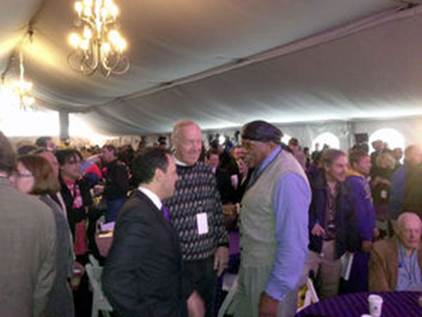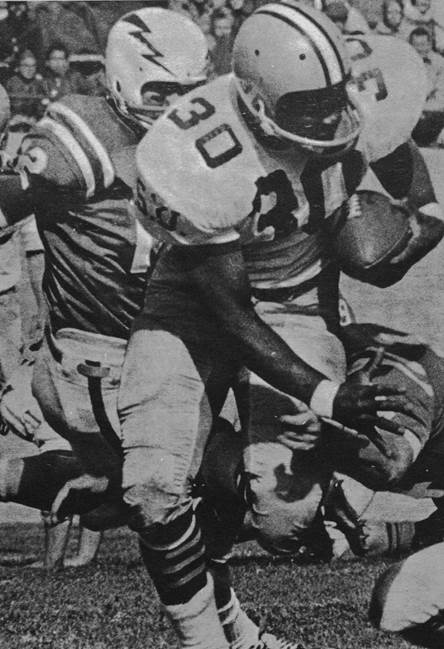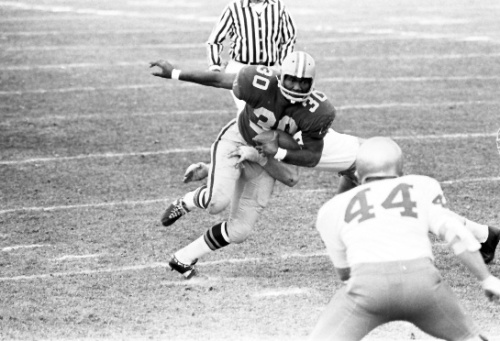

"IF YOU WANT TO SEE OPPONENTS BLEED, GIVE THE SEED TO OSCAR REED"
HELMET HUT NEWS/REFLECTIONS April 1 2016:
"IF
YOU WANT TO SEE OPPONENTS BLEED,
GIVE THE SEED TO OSCAR REED"
By Dr. Ken
Perhaps invoking the pre-Rap
patter of icon Muhammad Ali,
Minnesota Vikings cornerback
Earsell Mackbee put teammate
Oscar Reed’s name before the
football public after the team’s
27 – 0 dismantling of the
Detroit Lions in 1969’s annual
Thanksgiving Day game. Reed and
the Vikings, understated in ’69
and throughout the Bud Grant
years, remain among the most
unappreciated teams relative to
their achievements. For fans
actively engaged with
professional football throughout
the 1960’s and ‘70’s, we often
forget how difficult it was to
succeed in the game. Fewer teams
and smaller rosters necessitated
having players with multiple
skills and a lot more durability
than those of the modern game.
Numerous starters played on
Special Teams and full time
position players filled the
roles of place kickers and
punters although kicking
specialists were more abundant
by the mid to late-1960’s. The
emphasis on the running game
relative to the “basketball on
grass” offense of the 21st
Century made for a more
physically demanding contest,
especially when the coaching
emphasis was still on teaching
and executing blocking and
tackling fundamentals. Many fans
have also perhaps forgotten that
the National and American
Football Leagues did not have an
expanded playoff format designed
to hold the fans’ attention
until the last minute of the
season and squeeze every nickel
out of them. It was more
difficult to make it to the
league championship games and to
the Super Bowl. Finally, as a
culture, we have forgotten to
offer appropriate respect to
teams who consistently
demonstrated a level of
excellence that allowed them to
finish near or at the top for
many consecutive years, yet did
not win the ultimate prize. Of
course the 1990 – 1993 Buffalo
Bills come to mind but it was
the Minnesota Vikings from 1968
through 1977, whose long term,
year-to-year brilliance set a
largely forgotten standard and
something less than a legacy.
 |
Former Vikings Defensive End Carl Eller, young or old, was always the “fashion plate”
Compounding the Vikings four Super Bowl losses within their ten year period of success, was the approach and “style” of the team and its head coach. With few exceptions, the understated blue collar, attention-avoiding collection of players and coaches drew limited notice even during the seasons of their winning ways. While Carl Eller’s mink coats and Jim Marshall’s world-wide adventures garnered publicity, the rest of the squad seemed to appropriately represent the conservative work-a-day lifestyle of the upper Midwest.
Oscar Reed was typical of the Vikings’ players of the Bud Grant era and certainly younger readers can be forgiven if their response is “Oscar Who?” The Grant Vikings, in spite of Fran Tarkenton’s scrambling quarterback play, were a ball control, grind-it-out, solid defense type of team that was stripped down and rebuilt in his first season of 1967. The undisciplined Vikings of the Norm Van Brocklin era pooled talented, but mistake-prone players who could not win consistently. The steely Grant insisted on doing a few basic things as well as possible and he had a stable of running backs who strived to do that. While many insist that fullback Bill Brown was Hall Of Fame worthy, Dave Osborn and Oscar Reed were exceptionally productive and steady, if not flashy. Reed did in fact, come out of high school with the flashy nickname “Golden Shoes.” At Booker T. Washington High School in Memphis, Tennessee, it was standing tradition that an exceptional performance would grant the player the right to spray paint his shoes the school color of gold. Reed’s 240 yards and five touchdowns performance made him eligible and the name stuck. Understanding the necessity of hard work as the son of a Mississippi sharecropper who had moved to Memphis during Oscar’s childhood to make a better life for the family, Reed continued his academic and football journey at Colorado State University. CSU was not an obvious choice for any Tennessee high school football player but a sixteen game losing streak brought former Delaware line coach and former U.S. Marine Mike Lude to the Rams’ head coaching position. Lude’s inaugural season in ’62 added another ten consecutive losses. In a late 2015 interview, Lude reflected on his first season with CSU, admitting that lower level Delaware had far more talent. Even other coaches noted his desperate situation, as the Skyline Conference refused them admittance to conference play and Oregon State head coach Tommy Prothro approached Lude prior to their game and noted, “Mike, I’ve been watching you guys on film. You have one sh—ty team, do you know that?”
 |
Running back Oscar Reed set a slew of Colorado State records between 1965 and 1967
A change in philosophy
and approach, as the
local newspapers later
noted, forced the
program to go
“nationwide in its
recruiting.” This
explained the presence
of Memphis’ Reed and
Pittsburgh’s Jon
Henderson to the campus
in the fall of 1964.
Lude built a weight room
beneath the stadium and
insisted on a facility
upgrade. By 1966, he had
elevated the program to
a 7-3 count despite long
odds against him and
could very much thank
Reed, Henderson, and Jim
Oliver. The highlight of
that season was the
October 29, 12-10
upset of number
ten Wyoming on the
infamous Ron Wolfe to
Larry Jackson to Tom
Pack thirty-six yard
touchdown “Bounce Pass”
play, one that remains
legendary among CSU
fans.

While the lack of
adequate facilities
continued to hamper
recruiting and
eventually led to Lude’s
firing after 1968’s 2-8,
and ‘69’s 4-6 seasons,
he built a fine legacy
as an athletic director
in later years. Oscar
Reed’s legacy at CSU
also was stellar. He
ripped off a
seventy-eight yard
touchdown jaunt against
Hawaii on his very first
varsity carry and set a
new school rushing
record of 725 yards as a
205 pound sophomore. As
a junior in 1966 his
highlight day of 194
yards on the ground
against a very tough
West Texas State team
helped him to bump the
record to 946 yards with
twelve rushing
touchdowns, both CSU
records and marks that
left him as the nation’s
number eleven rusher
while ranked tenth in
scoring. As a fully
mature 5’11”, 215 pound
senior, he was featured
on the cover of the NCAA
Football Guide but
played sporadically in
‘67’s first three games
due to what was
described as a “leg
ailment.” Despite the
slow start, he rushed
for 910 yards and
completed his college
career with twelve
school records that
included 2581 rushing
yards at 4.7 yards per
carry and twenty-six
touchdowns.